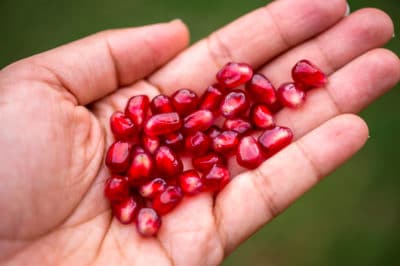What’s a Pomegranate?
Pomegranates are one of the oldest domesticated fruits. Native to Persia – the present-day country of Iran – the fruit is mentioned in ancient Greek writings. Travelers took pomegranates into India, which is now the largest commercial producer. The fruits are composed of multiple berries called arils, each of which is a seed surrounded by sweet flesh.
What Varieties Are Available?
Many pomegranate varieties have been developed, although some may be available only from specialty growers and nurseries. These are usually easy to find:
- Granada – sweet red fruit.
- Wonderful – the most common variety.
- Ambrosia – pale pink, long-lived.
- Cranberry – heavy crops, tart flavor.
- Eversweet – pink, non-staining juice, very sweet.
- Pink Satin – pink to light red, sweet juice.
Where Do Pomegranates Grow?
As you might expect given their native habitat, pomegranates prefer warm, dry climates. They do best in USDA Zones 8 to 10. However, a number of varieties can be grown in containers and moved inside for the winter months. Several varieties are also available in dwarf form and can be grown indoors year round in a sun room or greenhouse.
How Do I Obtain the Seeds?
The easiest way to obtain seeds is to simply buy pomegranates at the grocery store when they are in season. Nurseries typically sell seedlings grown from cuttings to ensure that the trees grow true to type. You may have to search a bit to find a source of seeds. You should recognize that whether you buy or harvest seeds, your fruits may be different than the original variety.
What About Soil?
Pomegranates will grow well in almost any kind of soil. In India, they even grow in rocky gravel. They prefer neutral to slightly acidic soil and a pH of 5.5 to 7. However, your soil must be well-drained, as these plants originated in arid climates and are susceptible to rot. If your soil is heavy clay, amend with coarse sand.
How Do I Prepare the Seeds?
If you harvested your own or bought fruit at the grocery, split the fruit and scoop out the arils. Rinse them in cool water and rub gently with a paper towel to remove the fruit pulp. Allow the seeds to dry for several days. Examine them and remove seeds that look misshapened or are broken. If you bought commercial seeds, no preparation is necessary.
How do I Plant the Seeds?
Commercial potting soil is a good choice for planting pomegranate seeds. You can also combine commercial potting soil half and half with commercial cactus mix to ensure you have good drainage. Another possibility is to combine garden soil with cactus mix or coarse sand. Plant seeds ¼ to ½ inch deep in moist soil. It takes about 30 to 40 days for pomegranate seeds to germinate in good conditions.
How Do I Water Pomegranates?
Although seeds and seedlings do need water, they are also susceptible to over-watering. If you start with moist soil and cover your seed container with plastic, you probably won’t have to water for several weeks. Use a fine mist to water the seedling container to prevent seeds from washing out. Once the seedlings sprout, water once a week or if soil seems dry.
How Do I Care For the Seedlings?
Warmth is once of the most important factors in growing pomegranate seeds. If you’re growing indoors, average house temperatures should be fine. You might also use a heat mat under the seed container to speed germination. Once the seeds sprout, give them bright light 10 hours a day. Water as directed above. Harden off seedlings before placing outside by exposing to the outdoors for a few hours each day.
When Do I Harvest Fruit?
It will take about four years for your trees to bear fruit. Like apples, pomegranates have a relatively long harvest period, especially if you plant different varieties. The earliest you can expect your pomegranates to ripen is August – Granada and Eversweet are the choices for a late summer crop. Most other pomegranate varieties begin to ripen in September and can be harvested through October.
